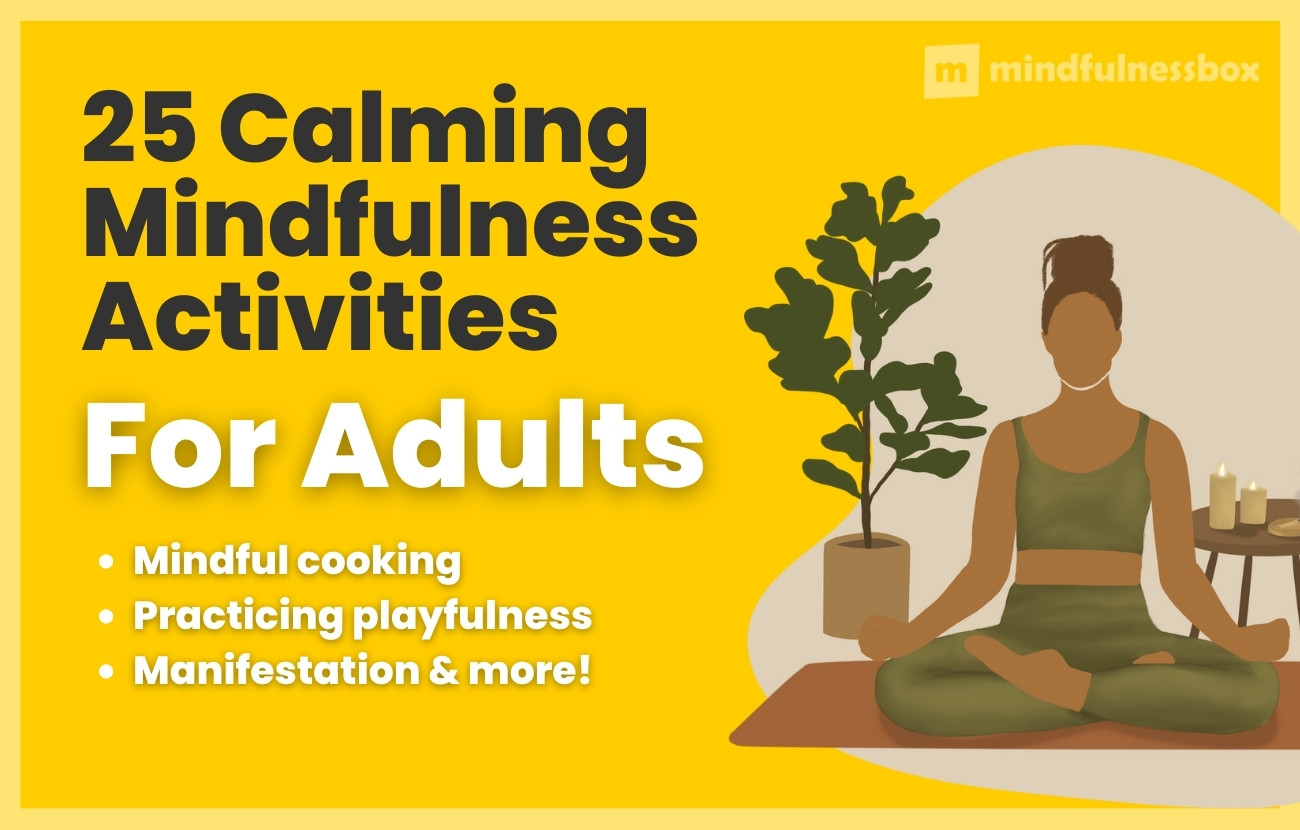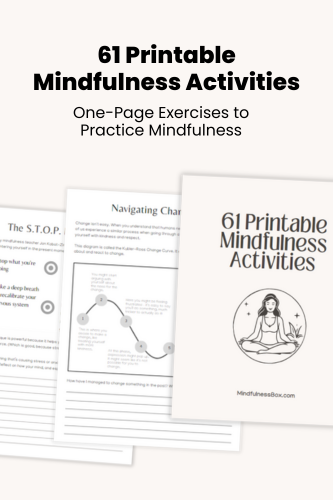Mindfulness activities for adults are much more diverse than the typical activities we think of first, like seated meditation and yoga. From gratitude to self-compassion, from mindful eating to mindful hugs, the options for incorporating mindfulness into your everyday life are endless.
Mindfulness is such a vast topic that sometimes it’s hard to know where to start. The answer, according to mindfulness expert Jon Kabat-Zinn, is to focus on one element of mindfulness at a time. Breaking your practice down into chunks can help make the process more manageable.
But what about when you’ve lost inspiration, or if you’re getting tired of typical mindfulness practices like meditation and yoga? What other mindfulness practices can help you bring awareness to your daily life?
Get dozens of one-page exercises to help practice mindfulness, meditation, gratitude, and self love. Perfect for printable handouts when teaching mindfulness to groups, students, or in the workplace.
To see examples, plus a full list of the 61 exercises included, click below.
That’s exactly what this list of 25 mindful activities for adults is designed to cover. Hopefully, they bring a new sense of inspiration and creativity to your mindfulness practice.
Looking for mindfulness activities for other age groups? Check out our articles on mindfulness activities for teens and mindfulness activities for kids.
25 mindfulness exercises for adults
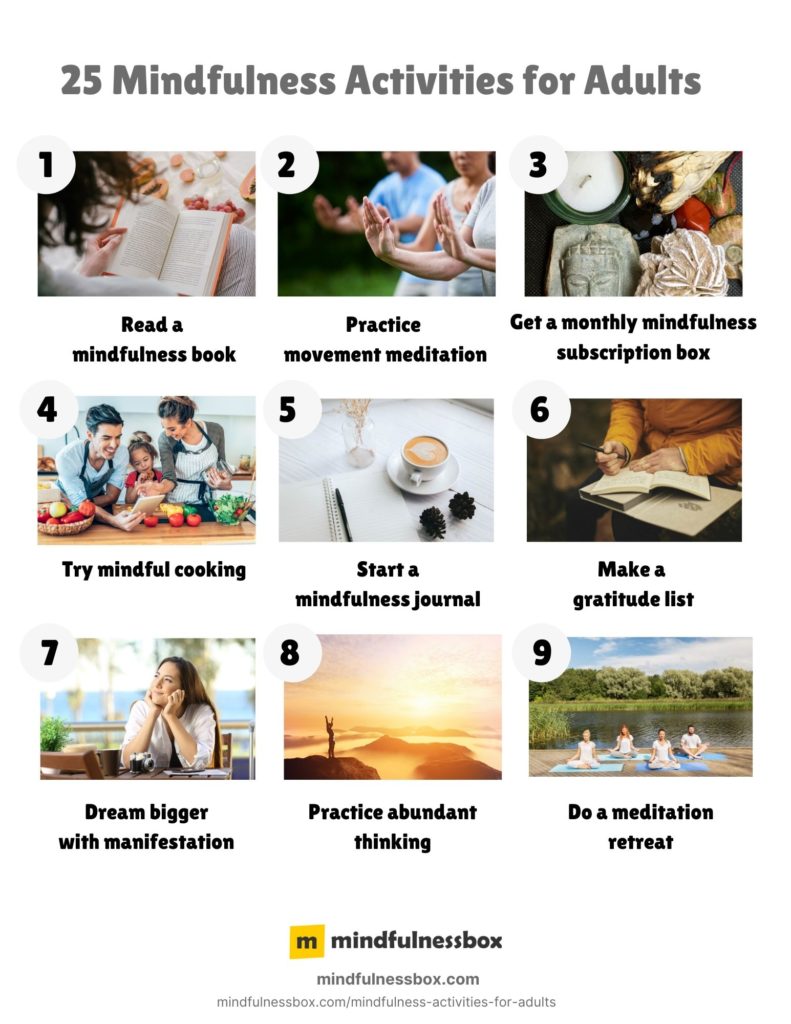
1. Read a mindfulness book
It’s incredible what you can learn by diving into the minds of the great spiritual teachers.
From the Dalai Lama to Jon Kabat-Zinn to Thich Nhat Hanh, the accumulated life knowledge of some of the wisest people to have ever lived is at your fingertips.
Want some recommendations? Check out my list of the best mindfulness books.
Take this to the next level by reading mindfully.
By practicing mindfulness while reading, you can develop a deeper connection with the text and enhance your overall reading experience.
Mindful reading can also help to reduce stress, improve focus, and promote relaxation.
Instructions for reading mindfully:
- Set the intention: Before you begin reading, set the intention to be present and fully engaged in the reading experience.
- Choose a quiet space: Find a quiet space where you won’t be distracted by noise or interruptions.
- Pay attention to your posture: Sit comfortably with your back straight, and keep your eyes at a comfortable distance from the text.
- Take a few deep breaths: Take a few deep breaths to relax your mind and body.
- Read slowly: Read the text slowly, taking time to absorb each word and sentence. Avoid rushing through the text or skim reading.
- Engage with the text: As you read, engage with the text by asking questions, making connections, and visualizing the scenes and characters.
- Take breaks: Take breaks as needed, to give yourself time to reflect on what you’ve read.
- Practice gratitude: Take a moment to appreciate the opportunity to read and learn, and the experience of engaging with the text.
2. Practice movement meditation
Fortunately, sitting still on a cushion isn’t the only mindfulness activity for adults.
If you’ve found yourself getting antsy after too long in sitting meditation, try experimenting with tai chi, qi gong, dancing, walking meditation, or other mindful movement activities for adults.
Consider starting with one of these:
- Qi Gong: Qi Gong is a Chinese practice that involves a series of slow and graceful movements, deep breathing, and mental concentration. It aims to balance the flow of energy in the body, promote relaxation, and improve overall health.
- Tai Chi: Tai Chi is another Chinese practice that involves a series of flowing movements and deep breathing. It is often described as “meditation in motion” and is known for its gentle and calming effects.
- Yoga: Yoga is a physical, mental, and spiritual practice that originated in India. It involves various postures, movements, and breathing exercises that aim to promote relaxation, flexibility, strength, and inner peace.
- Mindful Walking: Mindful walking is a simple but effective form of movement meditation. It involves walking slowly and intentionally, paying attention to the sensations in the body and the surrounding environment. It can be done in a natural setting, such as a park or forest, or in an urban area, such as a busy street.
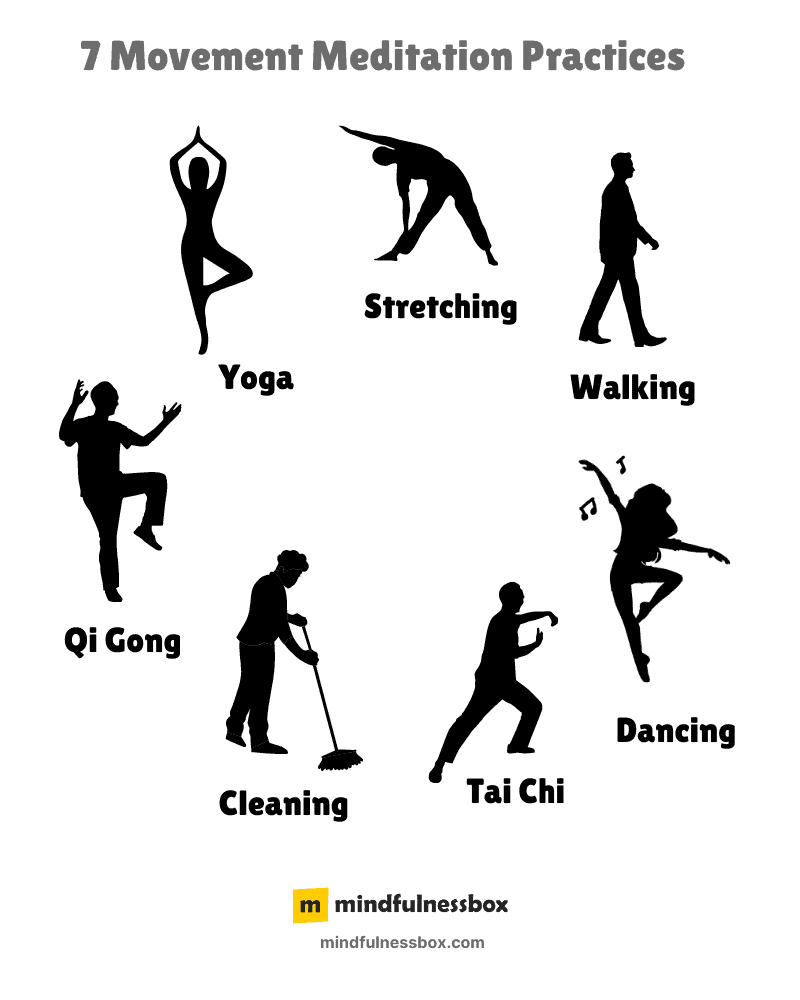
3. Get a monthly mindfulness subscription box
Do you find yourself losing motivation in your mindfulness practice? Ordering a mindfulness subscription box gives you a chance to do a “reset” of your motivation each month.
Knowing that you’ll get new tools and inspiration delivered to your door every month might be exactly what you need to keep growing your practice.
4. Try mindful cooking
Ever heard of mindful cooking? If you find yourself getting stressed or overwhelmed while cooking, you might be getting lost in thought instead of losing yourself in the present moment.
Mindful cooking is a way to bring yourself deeply into the act of chopping ingredients and cooking your meal. As a bonus, it helps you build patience and makes the whole cooking process more enjoyable.
Here’s a list of mindful cooking strategies for your next meal.
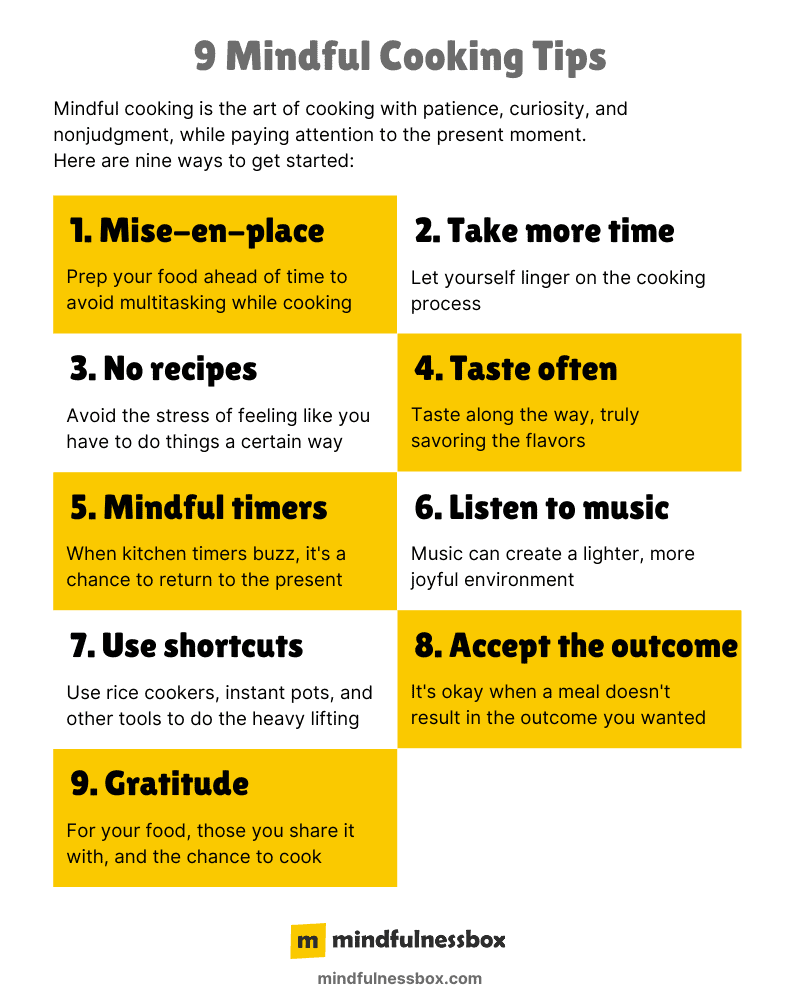
5. Start a mindfulness journal
Journaling is an excellent tool for introspection, but it’s also the perfect mindfulness activity because it allows you to clear your mind and turn jumbled thoughts into something concrete.
You can also use journaling as a mindfulness tool with mindfulness journal prompts that invite you to reflect on different aspects of mindfulness in your life.
Here’s a mindfulness journal template that’ll help you get started fast.
Or, check out this list of mindfulness journal prompts.
6. Make a list of things to be grateful for
There are so many reasons to be grateful that once you make a habit of looking for them, they start showing up everywhere.
(If you’re looking for inspiration, here are 101 reasons to be grateful.)
7. Dream bigger with manifestation
Manifestation might seem a little woo-woo if you haven’t tried it, but as I argue in my manifestation guide for skeptics, it’s essentially a supercharged version of traditional goal setting.
Rather than just giving yourself a goal, manifestation invites you to dream big, then create a detailed, emotional, and immersive visualization that makes it feel like you’ve already achieved what you set out to do. In a way, you’re hacking your mind’s expectations to pave the road that allows you to reach your goals.
8. Practice abundant thinking
Abundance is all about imagining that good things are coming your way, rather than getting caught up in limiting beliefs or constricted thinking.
If you’re interested in cultivating an abundance mindset driven by self-compassion, gratitude, affirmations, and possibilities, check out these abundance mindset examples.
9. Do a meditation retreat
You don’t have to do a ten-day silent meditation retreat like I did, but a meditation retreat of one day or more offers the opportunity to get much more meditation practice than you would normally.
Think of it this way: if you meditate for ten minutes each day, that means you get 60 hours of meditation practice in a year. At a retreat, you’re likely to get that much practice in a week.
Concentrated meditation practice in a retreat context can help advance your practice and provide a burst of motivation to continue further on your own.
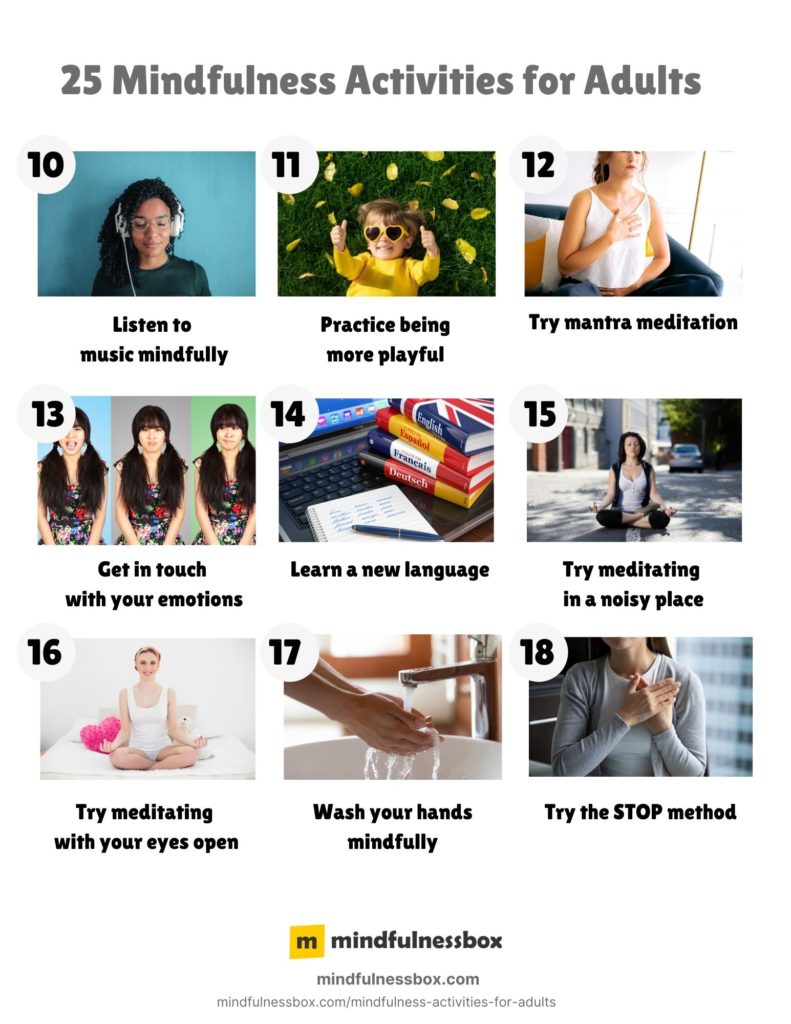
10. Listen to music mindfully
Here’s one of the most fun mindfulness exercises for adults:
Mindful music listening.
What does it mean to mindfully listen to music? By bringing your full awareness to whatever you’re listening to. When your attention drifts, bring it back to the present moment and the experience of listening to each layer of sound.
Wearing headphones and listening to a song that’s entirely new to you are a couple of ways to make it easier to listen to music mindfully.
Check out this graphic for more:
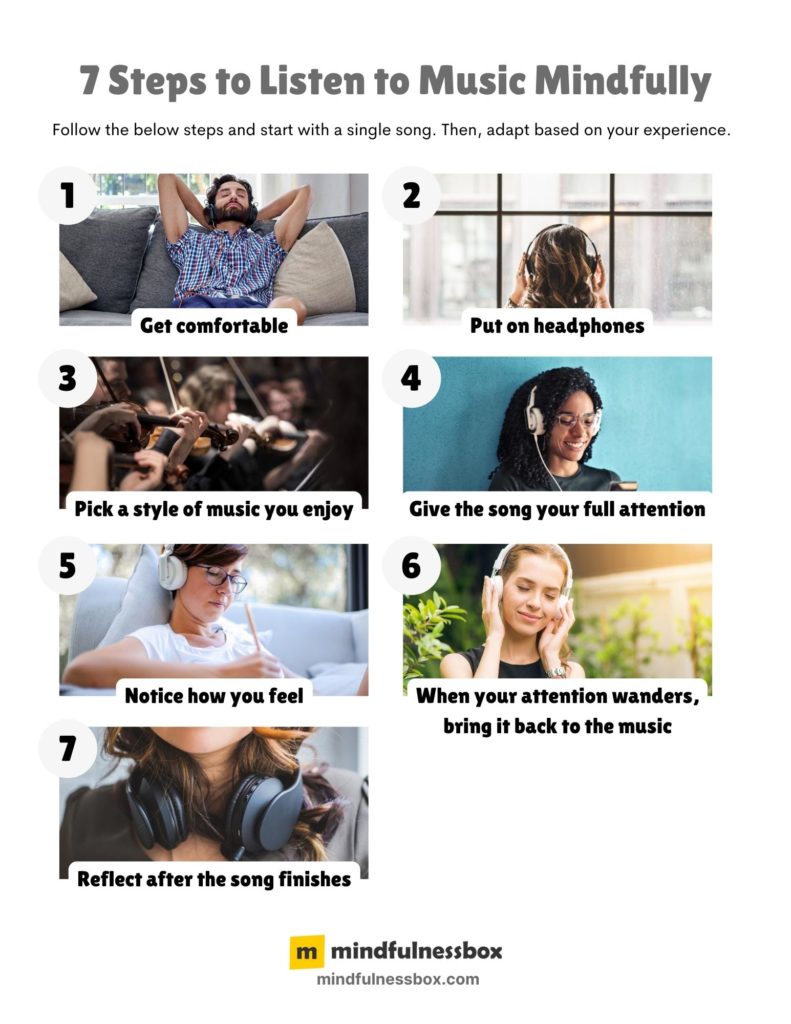
11. Practice being more playful
As we grow into adulthood and responsibilities feature more prominently in our lives, some of the playfulness of childhood naturally seeps out. (Well, for some of us. Others do an admirable job of keeping a childlike spirit). That’s why playfulness is one of the key mindfulness practices for adults.
If you’re looking for a quick framework for thinking about mindfulness, approaching life with a playful, childlike attitude is a great place to start.
Wondering where to start? Begin with these seven steps:
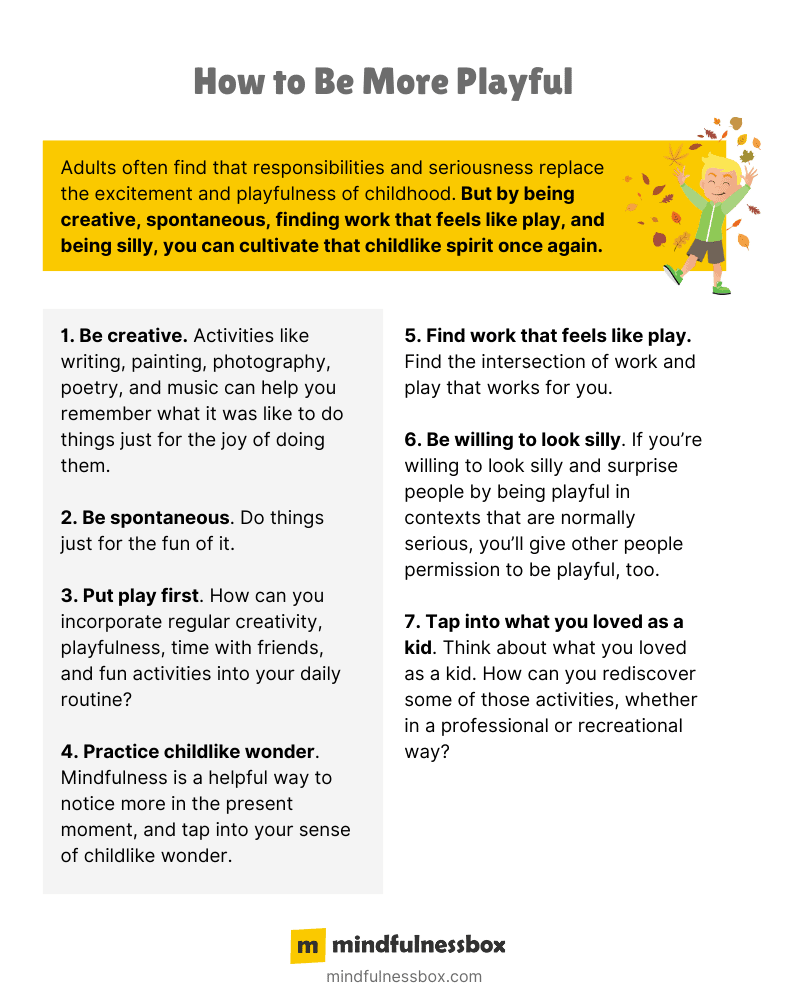
12. Try mantra meditation
Mantra meditation is a great way to mix up your meditation routine, especially if you’ve struggled with distraction during your meditation session.
Rather than focusing on your breathing or on a physical object of concentration, mantra meditation invites you to focus on the act of repeating a word silently inside your head. Usually, it’s something simple like “ah-hum.”
This is pretty beginner-friendly. Try it, and see if it comes any easier to you than other forms of meditation.
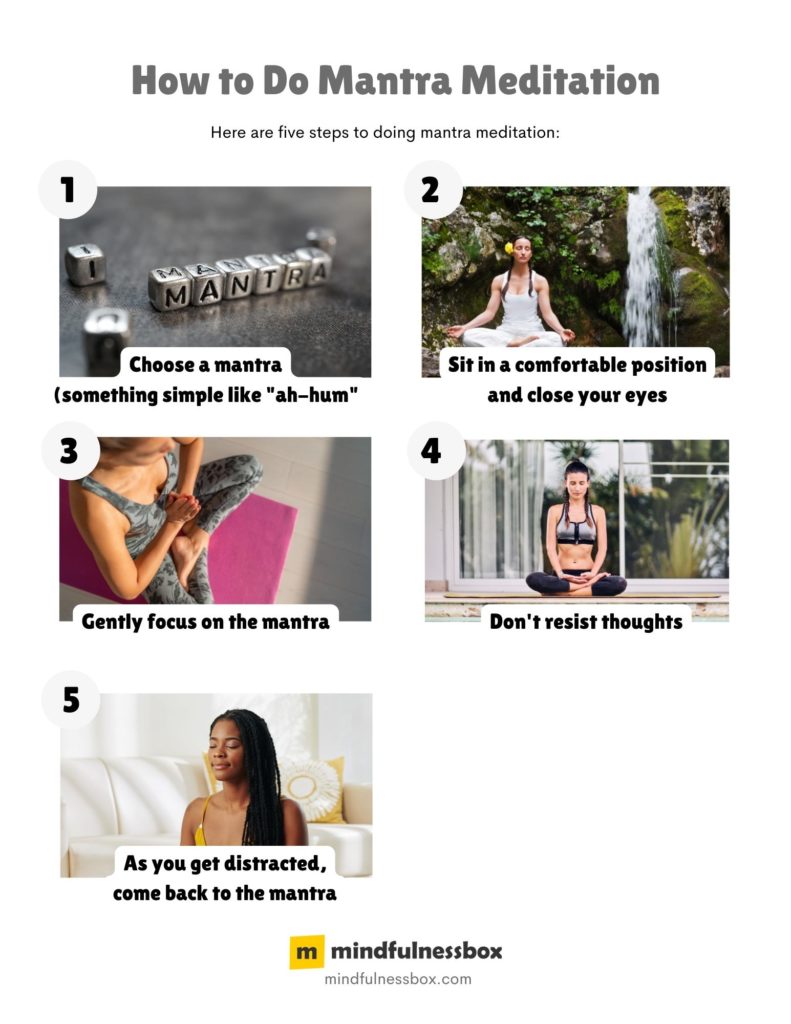
13. Get in touch with your emotions
Mindfulness is all about walking through life with awareness, rather than stumbling around on autopilot. But being aware of how you feel, and identifying the specific emotions that are coming up for you, are two distinct skills.
Consider learning about the eight primary emotions – like anger, fear, joy, and sadness – so you can practice identifying them as they come up, rather than letting your feelings go unknown.
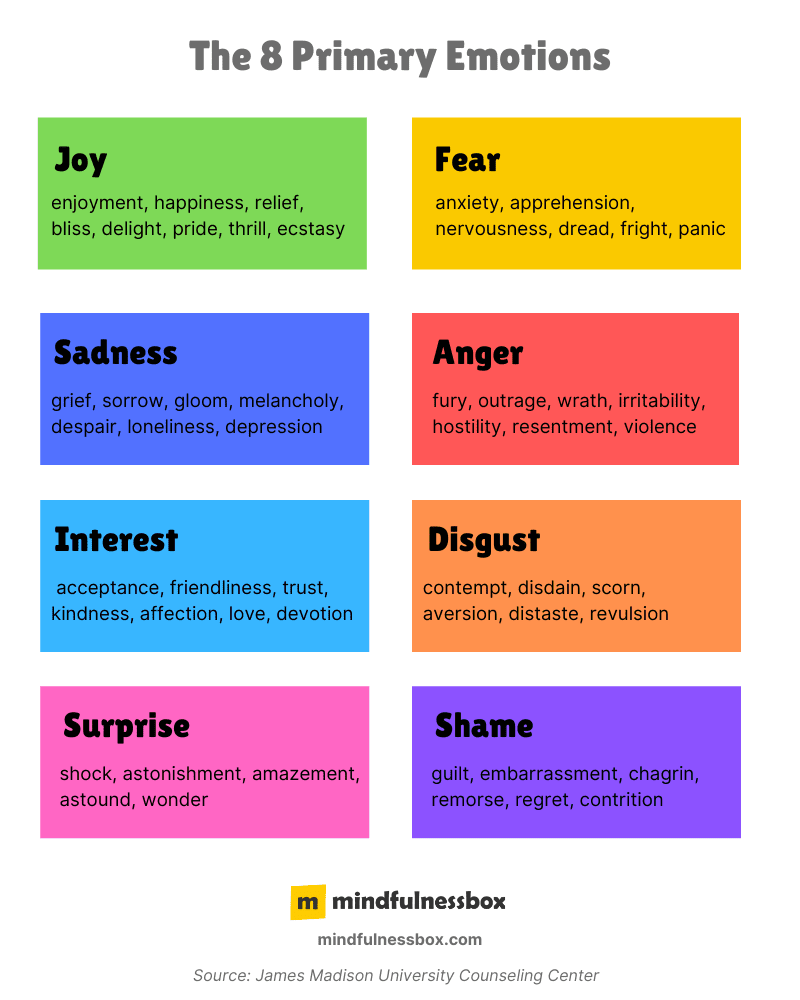
14. Learn a new language
Learning a language can be a great mindfulness hack!
Why? Because there’s no way to avoid the practices you need to engage in to develop your powers of mindfulness. When you’re speaking another language, particularly in another country, you’re forced to look at normal, everyday situations with new eyes.
Plus, you have to put yourself out there and be willing to make mistakes. The only way to do that in the long run is to practice nonjudgment and self-compassion towards yourself – key mindfulness skills.
15. Try meditating in a noisy place
Meditating in a silent room on a comfortable meditation cushion is great and all – but have you ever tried meditating in a noisy place?
It’s great for rewiring your expectations about meditation. Meditation doesn’t require silence. It’s not easy, but instead of focusing on your breath, try keeping an open awareness and letting your attention linger on whatever sounds come up in your environment.
Of course, if the jackhammers start, you might have to put headphones on. But if you’re in a place with nature sounds or normal city noises, you might find that meditating on the sounds of your environment adds a new angle to your mindfulness practice.
16. Try meditating with your eyes open
If you normally meditate with your eyes closed, try meditating with your eyes open. (Zen monks do it!)
There are pros and cons to each method, but keeping your eyes open might help you stay awake and alert during your meditation, and avoid the temptation that often comes with eyes-closed meditation to get lost in your imagination.
If you’re teaching mindfulness to adults, have them give this a try.
17. Wash your hands mindfully
Believe it or not, mindful hand washing has a firm place on the list of meditation activities for adults. It might just be the perfect mindfulness activity:
- It’s something you do many times a day
- It often happens in the privacy of a bathroom
- There are sounds and sensations to focus on
- Bathrooms often have a mirror; seeing your reflection can serve as a trigger to remind you to be mindful for 30-60 seconds while you wash your hands
To wash your hands mindfully, just do the same thing you normally do – but slower. Pay attention to each step of the process, and notice the feeling of the lathered soap on your hands, and the temperature of the water.
18. Try the STOP method
Ever need a quick mindful break? The STOP method is one of the most useful mindful exercises for adults because helps you reconnect with yourself.
Here’s how it works:
- (S) Stand up and breathe.
- (T) Tune into your body. Notice how it feels, and any physical sensations.
- (O) Observe. What is your body telling you?
- (P) Ask what’s possible. What new possibilities might emerge if you’re able to connect with yourself in this moment? How might this be a turning point for the rest of the day?
19. Turn dull moments into mindfulness exercises
Every day has a myriad of boring moments. You know the ones:
- Waiting at a stop light
- Standing in an elevator
- Sitting in the doctor’s office
- Waiting for water to boil
- Killing time in the grocery store checkout line
And on, and on, and on. The good news is that there’s space to turn these moments of boring downtime into mindful moments for adults.
Challenge yourself to turn some of these moments into opportunities for mindfulness. When you’re standing in the grocery store checkout line, wishing it would move faster, invite yourself to instead accept this moment as it is. Treat it with curiosity and openness. Pay attention to what’s happening around you with nonjudgment.
20. Practice self-compassion
Self-compassion is an essential skill for operating in the world, because so many of us walk around being hard on ourselves.
Instead, we need to treat ourselves as we would a dear friend or a child: with patience, understanding, forgiveness, and compassion.
If you catch yourself falling into a pattern of negative self-talk, challenge yourself to try a different approach. Ask yourself, “How would I treat a friend who was talking to herself or himself this way?”
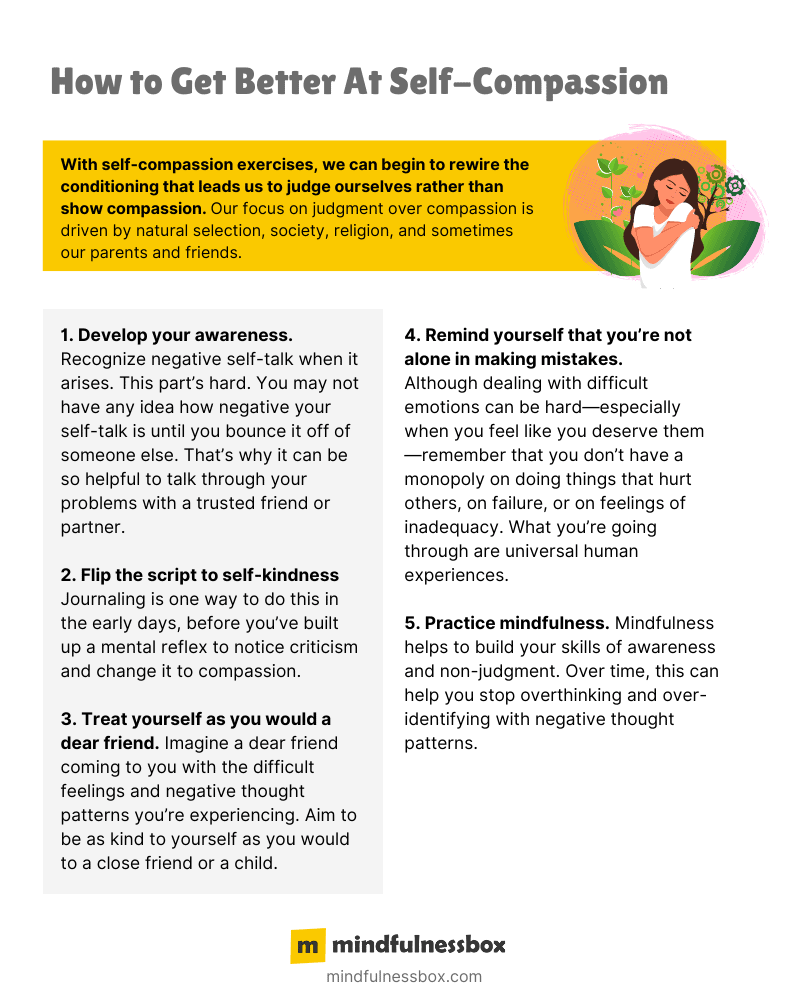
21. Hug someone
Hugging doesn’t seem like it’d be on a list of zen activities for adults.
But hugging is a vital mindful activity. If you’ve got someone to hug, do it as often as possible. Invite your partner, friend, or family member to take three deep breaths while hugging you, in order to balance your nervous system and release oxytocin.
Hugging is a great way to remind yourself of the strength of the mind-body connection. Often, what seems like an intractable feeling can be solved by moving your body or connecting with others.
22. Do the raisin mindfulness meditation
Here’s one of the most tried-and-true mindfulness group activities for adults:
The raisin mindfulness meditation is a classic practice that teaches you to linger on food, noticing the texture, taste, and smell on a deeper level than you normally would.
It doesn’t have to be done with a raisin, either. Pick your favorite food, or even a cup of tea, and approach it with intention, slowly.
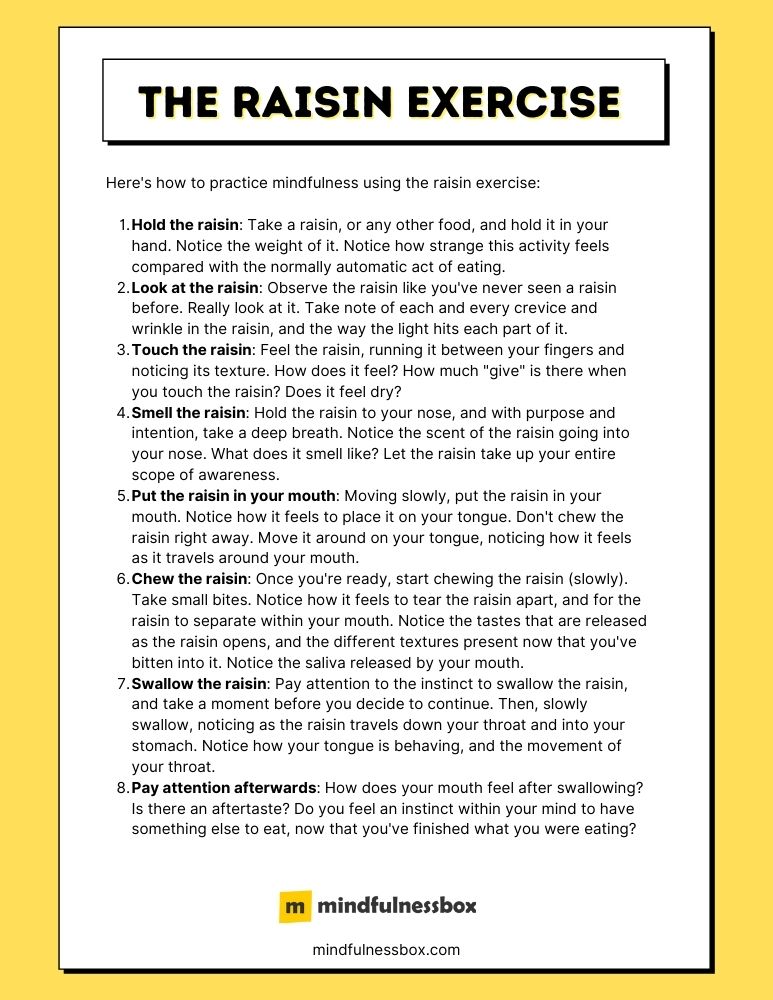
23. Stop reading the news
Reading the news can feel like something you need to do to be a responsible citizen, but the reality is that the daily news cycle is often a drip-feed of stress and anxiety that moves your focus onto things outside of your control.
Consider taking a pause from reading the news – even if just for a few days – and notice how you feel. If you find yourself calmer and more peaceful, ask yourself if you’d like to continue the experiment.

24. Try negative visualization
Counterintuitively, negative visualization is a way to appreciate what you have.
Here’s how it works. Imagine yourself at some point in the future, having lost everything you hold dear. Maybe you don’t have a job, or you’ve ended up alone, or you’ve encountered any number of challenging scenarios.
Then, zoom back out and return to your present self. Notice all the good that’s around you. Use the contrast of the negative visualization with your present experience as a way to build gratitude and appreciation.

25. Recognize what falls within your circle of control
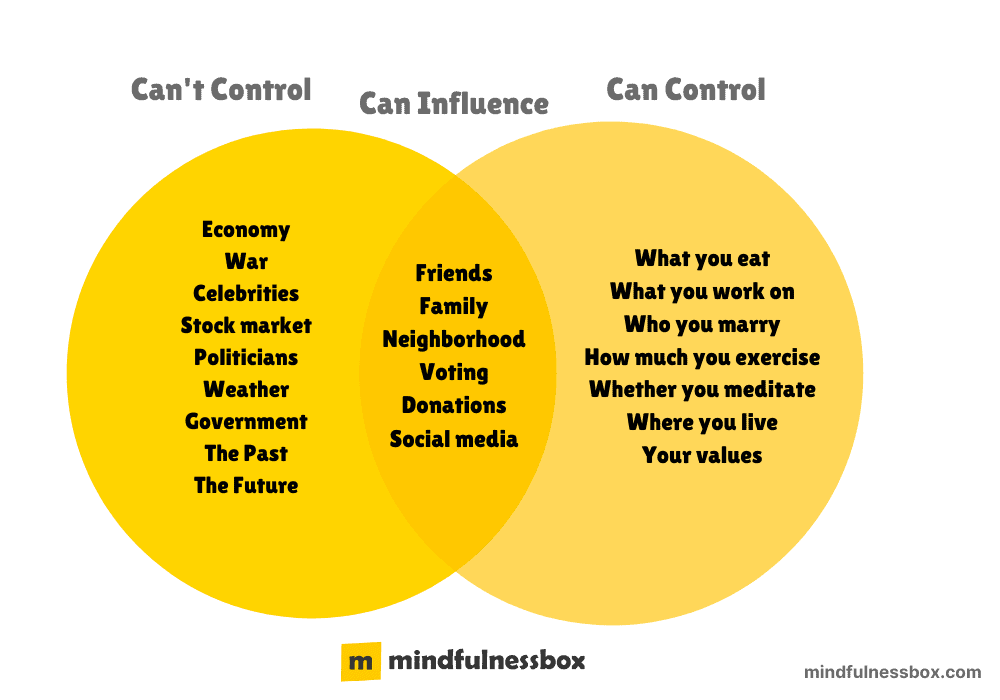
There’s so much in life that we have no control over: the stock market, the weather, politics, government, how other people choose to behave.
These things you have no way to control or affect fall within your Circle of Concern. Ask yourself how much of your mental energy is being spent here.
At the same time, there’s plenty in your life that you can control: where you live, your job, your attitude, your philosophy, what you read, who you marry, how much you exercise.
This is your Circle of Control. How would it feel if you focused more of your energy in this area?
Download this list as a mindfulness activities PDF
Interested in downloading this list of mindfulness activities as a PDF?
Just click the button below:

My mindfulness practice kicked off in 2016 with a ten-day silent retreat. Since then, I’ve read dozens of books about mindfulness and completed hundreds of hours of meditation. Thinking about what makes humans happy, calm, and peaceful is endlessly fascinating to me.

